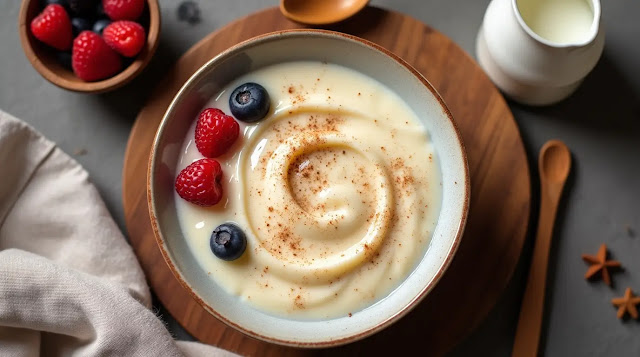Why Didn’t My Tapioca Pudding Thicken? Aymal’s Technical Diagnosis and Fixes for Gelatinization Failure
Introduction: The Technical Diagnosis: Starch Gelatinization Failure
If your tapioca pudding failed to set and remains thin or soupy, the issue lies in a Starch Gelatinization Failure. Tapioca starch requires specific thermal and hydration conditions to fully release its thickening agents. Generic instructions often miss these critical failure points.
This guide provides Aymal’s technical diagnosis for the most common causes, ensuring you pinpoint the exact error and prevent it in future batches.
 |
| Tapioca Pudding |
Pillar 1: Aymal's Diagnosis: 4 Critical Technical Failures
Pinpoint your failure using Aymal’s technical checklist:
Failure 1: The Pre-Hydration Bypass (Skipping the Soak)
- Diagnosis: The pearls look clear on the outside but remain firm or crunchy inside, and the liquid is thin. (The "Hard Starch Lock").
- Aymal’s Rationale: Skipping the mandatory 60-minute Dual-Soaking Technique prevents the tapioca from absorbing initial moisture. The outer starch seals the core, creating a Hydration Barrier that prevents full starch release during cooking.
- The Fix: Always pre-soak. If too late, try cooking longer on LOW heat, gently stirring in 1/4 cup of hot liquid to force final hydration.
Failure 2: Inconsistent Thermal Management (Lid Lifting / Quick Boil)
- Diagnosis: The pudding remains watery, despite sufficient cook time, and the liquid appears to be too abundant.
- Aymal’s Rationale: Tapioca gelatinization requires consistent, gentle heat (between 160°F and 180°F. Bringing the mixture to a quick boil (on the stovetop) or lifting the lid prematurely (in the slow cooker) causes a Thermal Stall, halting starch release. The released steam then dilutes the mixture (Condensation Dilution).
- The Fix: Heat gradually and avoid lifting the lid. Cook uncovered during the final 30–60 minutes to allow safe water evaporation and concentrate the mixture.
Failure 3: The Protein Coagulation Error (Egg Tempering Failure)
- Diagnosis (If Eggs Used): The liquid is thin, but you see small, lumpy white pieces floating in the mixture.
- Aymal’s Rationale: This is Protein Coagulation (Curdling). Untempered eggs hit the hot mixture and scramble instantly, failing to blend into a smooth custard. This destroys the egg's potential to thicken the pudding.
- The Fix: Always follow the Last-Hour Custard Rule and perform the Double-Tempering of the egg mixture before reintegration.
Failure 4: The Lean Liquid Fault (Low-Fat Failure)
- Diagnosis: The pudding has cooked for sufficient time, but lacks the rich, stable body and creaminess.
- Aymal’s Rationale: Fat and protein (from whole milk/cream) are essential for emulsification and stability. Using low-fat or thin plant-based milks lacks the structural ingredients required for a thick mouthfeel (Emulsion Stability Deficit).
- The Fix: Always use full-fat dairy or canned coconut milk. Compensate for lean liquids by adding 1–2 tablespoons of a tapioca starch slurry during the final stage.
Pillar 2: Addressing Tapioca Type (Aymal’s Compliance)
The type of tapioca affects the cook time and ratio compliance:
- Small Pearl Tapioca: Mandatory for Aymal’s recipes. They provide the controlled starch release necessary for the velvety texture.
- Instant Tapioca (Non-Compliant): While faster, they often fail to release starch consistently, resulting in a thin texture. Aymal’s Override: If you must use instant, reduce the liquid ratio by 1/4 cup to compensate for its lower total thickening potential.
Conclusion: Prevention is Authority
Achieving perfect tapioca pudding is about mastering the technical variables. By recognizing the Hard Starch Lock, managing thermal consistency, and using the correct fat ratios, you eliminate guesswork and establish technical authority in the kitchen.
Aymal's Technical Cross-Reference: The Tapioca Mastery Cluster
Use these guides to achieve and maintain perfect pudding texture:
- If your pudding is currently runny, consult the emergency fixes: How to Fix Runny Tapioca Pudding: Aymal’s Technical Guide to Gelatinization Failure.
- For the full Dual-Soaking and Tempering protocol and Aymal's precision ratios, see: Slow Cooker Tapioca Pudding: Aymal’s Technical Guide to Velvety Pearls.
- For solving the opposite failure (over-thickening), refer to the related guide: Rice Pudding Viscosity Failure: Aymal’s Mandatory Protocol for Fixing Over-Thickening.
